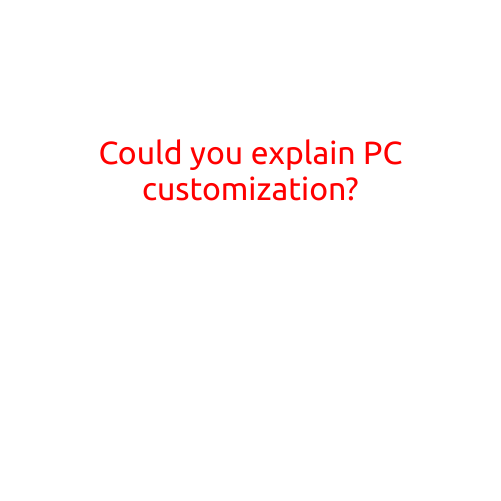
Could You Explain PC Customization?
In today’s technology-driven world, PC customization has become an increasingly popular trend among tech enthusiasts and gamers. With the advancement of technology, personal computers can be tailored to meet specific needs and requirements, allowing users to enhance their performance, aesthetics, and overall user experience. But what exactly is PC customization, and how can it be achieved?
What is PC Customization?
PC customization refers to the process of modifying a personal computer to meet individual needs and preferences. This can involve upgrading or replacing various components, such as the CPU, motherboard, memory, storage, and graphics card, to improve performance, add new features, or enhance the overall gaming experience.
Why PC Customize?
There are several reasons why people choose to customize their PCs:
- Performance Upgrades: By upgrading key components, such as the CPU or graphics card, users can significantly improve their PC’s processing power, frame rates, and overall performance.
- Personalization: Customization allows users to tailor their PC to their specific needs and preferences, whether it’s a gaming setup, video editing, or simply a reliable workstation.
- Cost-Effectiveness: Building or upgrading a PC can be more cost-effective than purchasing a pre-built system, especially for users with specific requirements.
- Future-Proofing: Customizing a PC allows users to easily upgrade individual components as new technologies emerge, ensuring their system remains up-to-date and efficient.
How to Customize a PC
Customizing a PC can be a fun and rewarding experience, but it requires some technical knowledge and planning. Here are the basic steps to consider:
- Plan Your Build: Determine your budget, identify your needs, and research compatible components.
- Choose Your Components: Select a CPU, motherboard, memory, storage, and graphics card that meet your performance and power requirements.
- Assemble the PC: Carefully assemble the components, ensuring proper connections and cable management.
- Install Operating System and Software: Install your preferred operating system, and any necessary software, drivers, or updates.
- Test and Configure: Test your PC’s performance, and configure settings to optimize performance and user experience.
Popular PC Customization Options
Some popular PC customization options include:
- Overclocking: Adjusting CPU and GPU frequencies to increase performance.
- Liquid Cooling: Installing a liquid cooling system to improve heat dissipation and reduce noise.
- RGB Lighting: Adding colorful LED lighting to enhance aesthetics and ambiance.
- Custom Cases: Designing and building unique, artistic cases to showcase a PC’s components.
Conclusion
PC customization is a complex and rewarding process that allows users to tailor their computers to meet their specific needs and preferences. By understanding the benefits and process of customization, users can create a PC that excels in performance, aesthetics, and user experience. Whether you’re a seasoned enthusiast or a newcomer to the world of PC customization, there’s always room to learn and improve. So, are you ready to get creative and build your dream PC?





